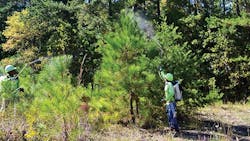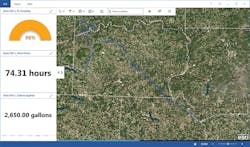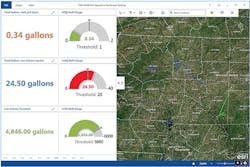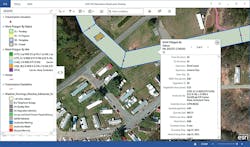Herbicide Management Innovations & Initiatives
There are many misconceptions about how utilities maintain power lines and ecosystems within the transmission power grid. Utility vegetation management departments go to great lengths to manage trees and brush along the lines as well as to comply with strict federal and state mandates.
Property owners and customers, for the most part, are unaware of the time and energy invested by utilities to maintain the power network and manage ecosystems within their footprint. Some may think utilities indiscriminately apply herbicides with little regard for the environment or their community. Others may see the expanse of the electric grid as a blight to scenic America.
Now more than ever, the voice of the community is being heard. Successful utilities are focusing more on customer engagement by investing in new capabilities, programs and technologies that enable them to communicate more effectively.
Field Technology to Manage Brush
Duke Energy is evaluating new ways to protect the environment and promote the native flora and fauna within its rights-of-way (ROW). This includes several recent field trials that demonstrate the utility’s commitment to customer engagement and environmental stewardship within its vegetation management program.
In the first test of new management methods, Duke Energy deployed mobile-enabled software to automate data collection and track herbicide use in a digital map. McKim & Creed Inc., an engineering, surveying and planning services firm, agreed to support this effort in collecting and analyzing light detection and ranging (LiDAR) data to model brush inside the ROW.
With digital-span polygons and brush areas from the LiDAR survey and analysis in development, the team began looking ahead at how best to execute the spray work in these corridors. Printing maps with this information was feasible, but it came with many of the common limitations found when working with paper maps and records.
With paper, trying to calculate the amount of chemical mix used and creating a daily report is cumbersome and fraught with the potential for errors. Spot-checking work is difficult because the herbicide crews move rapidly through the service territory. And addressing customer inquiries and work exceptions is challenging because paper maps containing this information from the spray crews often do not reach the utility until after the work is completed and the crews have moved to other areas.
To address these challenges, CWC Chemical recommended using mobile spray tracking software that was recently used by another utility in the southeastern U.S. CWC Chemical and Clearion Software set up a proof of concept to load the transmission line information, the polygons from the work plans (brush density and height), and the utility background asset data and imagery into mobile mapping software. This would permit the spray crews to view the data and create electronic work records.
The herbicide applicator, Superior Forestry, agreed to try the CWC Spray Tracker software, provided it was simple to use and did not hinder the crews. The Superior Forestry spray crew received a GPS-enabled tablet loaded with a digital map of the span and brush polygons, aerial imagery, roads and land layers, as well as the utility access routes layer.
A Mobile Herbicide Field Trial
After a day-and-a-half of in-field training, the crew leader began recording work progress in the mapping system and documenting the mix type applied, the number of hours worked in each span, the date and time of work, the herbicide drum number and any inquiries or exceptions.
During the first part of the trial, crews recorded gallons applied by the chemical mix and application method at each span polygon. The crew leader quickly learned keeping up with the crews was impossible while stopping at every polygon to enter the work completed.
Another approach was considered. Instead of recording data at each polygon, the crew leader entered gallons applied at the end of each day. This method, while reducing the level of detail, increased the speed of the crew general foreman entering the data. The Aqumix closed chain of custody system was used, linking returnable/refillable containers to custom chemical blending while maintaining current and historical information.
At the outset of the trial, a few points were considered:
• Digital maps would be used in the field with polygons depicting brush density, aerial imagery and access points unavailable on paper maps.
• Crews would track gallons applied by chemical mix and application method based on brush density.
• The tool would enforce consistency and standardization, as well as legibility.
Throughout the day, the crew leader reviewed the work recorded and then synchronized the data to a secure server managed by Clearion. Each time the crew leader clicked the sync button, the information was instantly available on the server.
Clearion also configured a secure web portal that provided real-time access to the work the crews posted throughout the day. Both CWC Chemical and the Duke Energy managers received log ins to the portal and could monitor work progress, herbicide consumption and customer inquiries in a map with a summary of gallons and acres in an operations dashboard.
Having visibility to the daily crew activity streamlined the herbicide tracking and reporting process. The utility was able to track the customer inquiries and quickly send a forester to the landowner’s property to answer questions while crews were still in the area. This was impossible with the paper process, as it took weeks to receive the customer inquiry report.
The herbicide field trial provided valuable insights that were not even considered at the outset. The utility was able to do the following tasks:
• Track and locate crews in near real time for field visits using the operations dashboard (which was not possible with the legacy paper process)
• Spot-check work, review skips and investigate customer inquiries and other notes in near real time
• Log an electronic chain of custody record for herbicide that can be archived and made available for future reference to better manage brush and treatment options.
Duke Energy demonstrated it could improve brush management within its ROW using new techniques. The mobile field trial improved the planning process as well as scheduling and assignment of work to the applicator crews. Dashboards enabled real-time communications between Duke Energy and the contractor by improving oversight of field operations and enabling the supervisor to make better decisions from the desktop.
Because the field data was accessible electronically, daily spray reports were generated at the push of a button. In the future, Duke Energy will be able to access accurate information for analysis and forecasting, and will be able to easily extend the solution to automate budgeting and purchase order management.
Restoration of Native Pollinators
While the primary function of a utility corridor maintenance program is to ensure the safe and reliable transport of power to customers, the utility also invests in integrated vegetation management (IVM) practices that promote and maintain a diverse, early successional plant community. Native pollinator populations can be challenged by changes in habitat.
While many factors contribute to habitat change, Duke Energy is performing test plots with the goal of improving forage and nesting resources for native pollinators. Controlling nonnative invasive plants such as lespedeza and autumn olive through selective herbicide application enables the expansion of native forbs beneficial to pollinators. Restoring native pollinator habitat is critical to our ecosystems.
The utility is fostering a natural habitat for these pollinators by establishing two test locations within its ROW in Durham and Greensboro, North Carolina, for this important initiative. The pollinator field tests are in process and, through a partnership with Bayer and IVM Partners, Duke Energy intends to demonstrate the following:
• By using U.S. Environmental Protection Agency-approved herbicides to manage ROW and promote low-growing native plant communities, its IVM program is beneficial to pollinators.
• The products used help to eliminate woody stems, making way for lower-growing, flowering shrub growth that is more compatible for utility access and infrastructure.
• Such lands remain unplowed and, thus, provide open areas for ground-nesting bees and dead woody vegetation (from selective herbicide treatment) for cavity nesting species.
• The native plants, which seed in and are released from woody competition, are conducive to pollinator health.
• Utility easements represent long linear strips of land that serve to connect wild and agricultural landscapes, providing valuable movement corridors necessary for the maintenance of healthy insect populations.
Routinely Assessing ROW
For Duke Energy, the objective is always to put the customer first; provide a safe environment for its employees, its contractors and the community; and promote the plants and wildlife within the ROW. As such, it is critical to assess the current approach for vegetation management on a routine basis within the utility ROW, as initiatives can be identified to improve operations, communications and conservation.
As demonstrated, field trials enable a limited scope of work to be accomplished in a short period of time within a controlled environment. These trials provide an opportunity for the utility, its partners and the customer to benefit from the activity and determine whether to take the next step into full implementation.
Jeff Racey is the system transmission forester for Duke Energy in vegetation governance, responsible for aligning the transmission vegetation management organization with industry best management practices through standardization of policies, processes and procedures across the organization’s service territory in parts of six states in the Midwest, Carolinas and Florida. Racey holds a BS degree in forestry and wildlife management from Virginia Tech as well as an MBA. He has been in utility forestry for 29 years, and is an ISA certified arborist, utility specialist and tree care safety professional as well as a registered forester.
Korey Meadows earned a BS degree in forest management from North Carolina State University in 2007, worked in vegetation management as a contractor and is now an employee of Duke Energy. His certifications include North Carolina Registered Forester and ISA certified utility arborist. He also holds a North Carolina pesticide applicator license and sits on the North Carolina Vegetation Management Association Board.
Karen Smith is a 25-year veteran of the utility and telecom industries and a graduate of Mercer University. She has helped multiple investor-owned utilities achieve corporate goals through successful projects involving the design, acquisition and implementation of GIS software, engineering and data services, and is now focused on new business development for Clearion Software. Smith is an active member of the Geospatial Information Technology Association (GITA Southeast).





